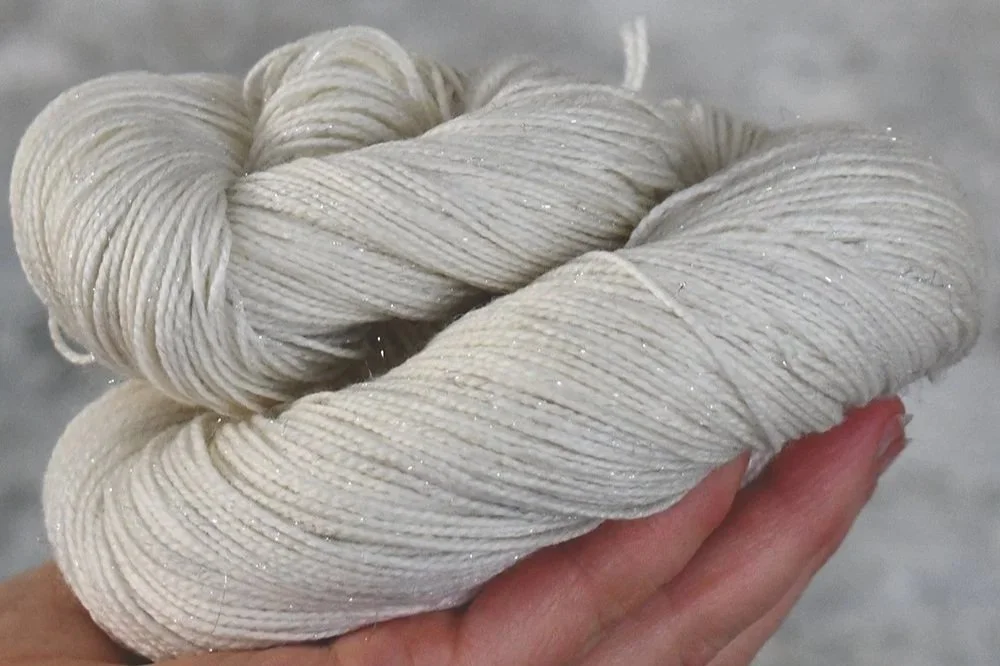One of the most common questions we receive is about how to treat stellina when dyeing. Stellina is used in our sparkle bases, and we sometimes get questions with respect to the dulling of the sparkle which some dyers occasionally experience when they dye it, in addition the sparkle can taking on the colour of the dye. We have worked with this fibre for years, and these are tips for dyeing sparkle yarns succesfully.
How to keep the sparkle in your yarn sparkly!
Contrary to popular belief, stellina is not actually metal, its a type of metallic toned nylon. Sometimes with excess acid when dyeing, the acid basically degrades the surface of the nylon and takes away the metallic tone, this can make the sparkle seem to have disappeared, it hasn't, it's still there, but just blends in with the other fibres, but it's no longer sparkly.
Basically there are three rules of thumb that affects the sparkle:
The longer the sparkle is in contact with acid, the more likely the stellina is to dull.
The higher acid concentration you are using the more likely the stellina is to dull.
Anecdotally citric acid causes more dulling than vinegar.
High acid (especially citric acid) + a long time in contact with the acid the more likely you are to get dull sparkle!
Acid levels: Reduce the amount of acid you are using when dyeing these particular yarns. Lots of dyers have found that vinegar is less abrasive than citric acid. My own experience of dyeing this yarn holds with this theory in that I have dyed an enormous amount of stellina (always using vinegar), and never had a problem with the sparkle dulling. However after much research and testing, I'm convinced its more down to the acid concentration levels rather than which acid is used, so don't worry if you have a preference for citric acid.
How much acid you use is obviously a personal preference, I am not a specific dyer, and don't use exact amounts, it's more of a table spoon here and a glug of vinegar there, but to give you an idea about how much I would use with a sparkle yarn its as follows:
For one Jam jar/ 1.5cups of dye with one teaspoon of dye:
Vinegar: approximately 1 Tablespoon of vinegar.
Citric acid: approximately 2 teaspoons.
If I was adding the acid into a kettle I would probably use about 1/4 cup of vinegar and 2 table spoons of citric acid.
If you use significantly more acid than this, and are worried about reducing the acid levels that much, I would suggest starting at the amount I have suggested and working upwards, keep increasing until you get a satisfactory dye uptake vs your sparkly staying sparkly (you don't need to use a whole skein each time, take a few feet and test it).
High heat is going to be your friend if you are decreasing your acid level, and I say this because sometimes when I'm helping people with this issue, especially with low immersion dyeing, it inevitably comes out that peoples dyeing temperatures are really not very high, (below 80C / 176F and this means it can take hours for the dyes to set, this will be exacerbated if less acid is being used than normal as well so finding a way to increase your temperatures to make the process more efficient is something to consider, using lids on your pans to maintain internal pan temps or even a final steaming of the yarns can help once the initial dye is in the yarn etc.
Reducing the time the yarn is in contact with the acid: Instead of adding acid to your yarn pre -soak, add your acid directly to your dye solution, or dye bath. If you pre-soak your yarn before you dye with it, just soak your sparkle yarn in plain water (no need to add any scouring agents). Consider increasing your heating temps to make the exhaustion time quicker, (one reason I like to steam set yarns is because it sets quicker than the microwave or oven, for me anyway.)
Sparkle taking on colour of the dye: Sometimes the sparkle takes on the colours of the dyes being used, especially with saturated and dark colours. Because the stellina is nylon, it can sometimes absorb some dye, although not quite at the same rate as wool. I personally quite like this effect, but to stop this from happening, add the yarn into a cold dye bath and then bring it up to temperature this will stop the stellina taking up the dye colour.
I hope this is helpful! If you have any other tips or comments please feel free to leave them in the comments section.
Jeni


